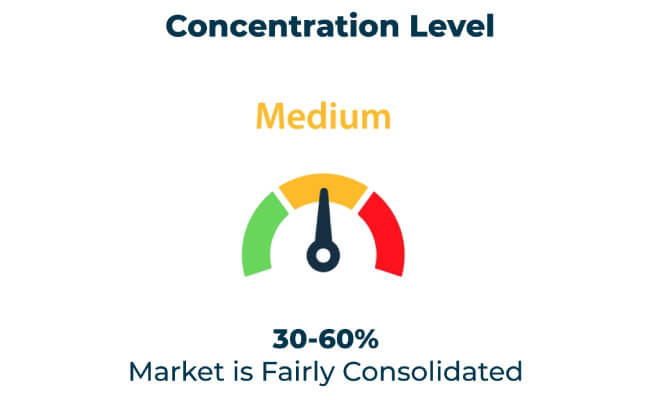The flexible plastic packaging market is growing rapidly because of the ever-increasing demand for lightweight, durable, and cost-effective solutions in food and beverages, personal care, and pharmaceuticals industries. By 2035, the market size is expected to grow to USD 181.2 billion with a compound annual growth rate (CAGR) of 4.6%.
The demand is increasing for sustainable materials and convenience among consumers, along with technological advancements related to barrier properties and design.
| Attribute | Details |
|---|---|
| Projected Value by 2035 | USD 181.2 billion |
| CAGR during the period 2025 to 2035 | 4.6% |
Manufacturers are increasingly looking at recyclable and biodegradable materials, advanced production technologies, and customization to suit the diverse needs of consumers and industries. It also has strategic partnerships with top brands, retailers, and e-commerce platforms driving the market expansion.
Exclusive Offer: 30% Off on Regional Reports
Get a free sample report and customize your regions for a 30% discount on your regional report!
Summary
Major players in the flexible plastic packaging market are positioned according to the SWOT analysis. Amcor is the leader with its advanced sustainable solutions but has difficulties in penetrating the regional markets. Berry Global has the cost-effective and customizable designs but faces volatility in raw material prices.
Sealed Air is focused on high-performance barrier materials, but new entrants pose strong competition. Innovation in biodegradable plastics and in the untapped markets will be opportunities, while the threats arise from regulatory changes and consumer rising expectations for sustainability.
Amcor
Amcor demonstrates strengths through its innovative use of recyclable and sustainable materials. However, the company’s weaknesses lie in limited penetration in certain emerging markets. Opportunities include collaborations with global brands to enhance eco-friendly packaging solutions. Threats arise from intense competition and evolving regulatory landscapes.
Berry Global
Berry Global is known for its cost-effective and flexible packaging solutions, which are also customizable. However, it is facing difficulties because of the raw material cost volatility. The company can look at automation and advanced material technologies to cut costs and increase efficiency. Nevertheless, there are threats of increasing regulatory scrutiny and competition from low-cost manufacturers.
Sealed Air
The strengths of Sealed Air are mainly in the aspect of high-performance barrier properties, as well as innovative packaging designs. Its weaknesses lie in the production costs being more expensive than the competition. It has opportunities from advanced materials toward biodegradable and recyclable packaging. Threats include increasing competitive forces from the smaller, innovative competitors and global regulatory pressures.
| Category | Market Share (%) |
|---|---|
| Top 3 Players (Amcor, Berry Global, Sealed Air) | 15% |
| Rest of Top 5 Players | 09% |
| Next 5 of Top 10 Players | 07% |
Type of Player & Industry Share (%)
| Type of Player | Market Share (%) |
|---|---|
| Top 10 Players | 31% |
| Next 20 Players | 40% |
| Remaining Players | 29% |

Year-on-Year Leaders
North America and Europe enforce stringent regulations to reduce single-use plastics, promoting innovations in recyclable and biodegradable materials. Asia-Pacific’s rapid industrialization and urbanization create opportunities for eco-friendly solutions amidst growing regulatory frameworks.
Check Free Sample Report & Save 40%!
Select your niche segments and personalize your insights for smart savings. Cut costs now!
Emerging markets in Africa, South America, and parts of Asia-Pacific offer significant growth potential. Affordable and scalable flexible plastic packaging solutions are in demand to meet regulatory requirements and evolving consumer preferences.
In-House vs. Contract Manufacturing
Regional dynamics play a pivotal role in the flexible plastic packaging market. North America leads with advancements in sustainability and convenience-driven packaging. Europe emphasizes innovation in biodegradable materials, while Asia-Pacific’s growing consumer base and industrialization drive significant demand. Emerging markets offer opportunities for cost-effective and durable packaging solutions.
| Region | North America |
|---|---|
| Market Share (%) | 35% |
| Key Drivers | Sustainable and innovative packaging demand. |
| Region | Europe |
|---|---|
| Market Share (%) | 30% |
| Key Drivers | Focus on biodegradable and recyclable options. |
| Region | Asia-Pacific |
|---|---|
| Market Share (%) | 25% |
| Key Drivers | Urbanization and expanding food delivery market. |
| Region | Other Regions |
|---|---|
| Market Share (%) | 10% |
| Key Drivers | Growth in emerging markets. |
The flexible plastic packaging market will expand through material innovations, automation, and strategic partnerships. Companies focusing on sustainable and durable solutions will gain a competitive edge. Investment in recycling infrastructure will further boost adoption.
| Tier | Key Companies |
|---|---|
| Tier 1 | Amcor, Berry Global, Sealed Air |
| Tier 2 | Mondi Group, Huhtamaki |
| Tier 3 | Constantia Flexibles, UFlex, Novolex |
The steady growth of flexible plastic packaging lies behind the sustainability goals, consumer preference for convenience, and innovations in materials. Companies investing in eco-friendly solutions, automation, and strategic collaborations will take the lead in this changing market.
Key Definitions
Abbreviations
Research Methodology
This report is based on primary research, secondary data analysis, and market modeling. Insights were validated through industry expert consultations.
Market Definition
The flexible plastic packaging market includes films, pouches, and bags designed to enhance convenience, sustainability, and durability across multiple industries.
Rising demand for lightweight, durable, and sustainable packaging solutions.
The market size is expected to grow to USD 181.2 billion with a compound annual growth rate (CAGR) of 4.6%.
Leading players include Amcor, Berry Global, and Sealed Air.
Key challenges include high costs of sustainable materials, regulatory complexities, and limited recycling infrastructure.
Opportunities lie in advanced materials, strategic partnerships, and innovations in sustainability.
Explore Plastic Packaging Insights
View Reports
Thank you!
You will receive an email from our Business Development Manager. Please be sure to check your SPAM/JUNK folder too.